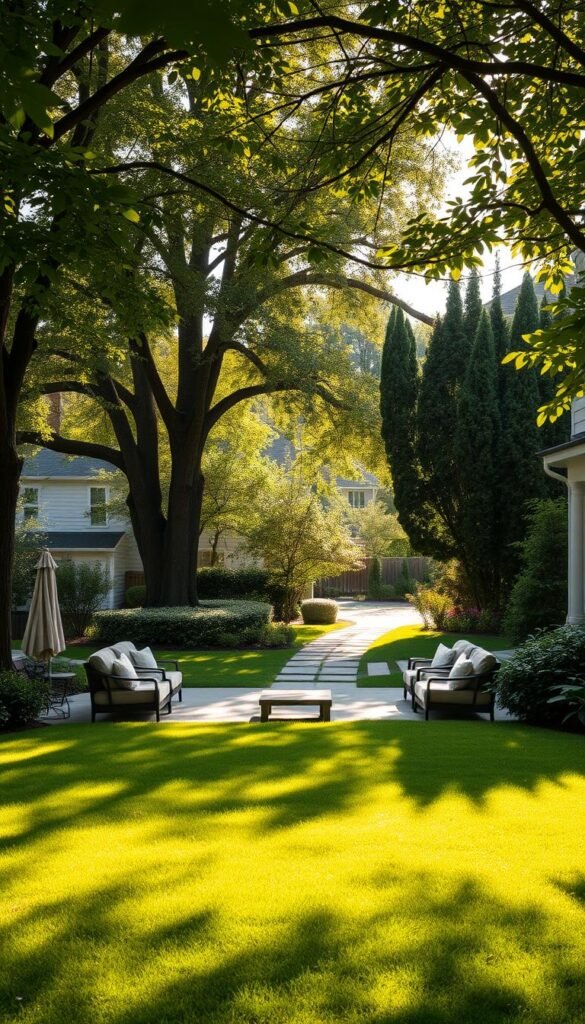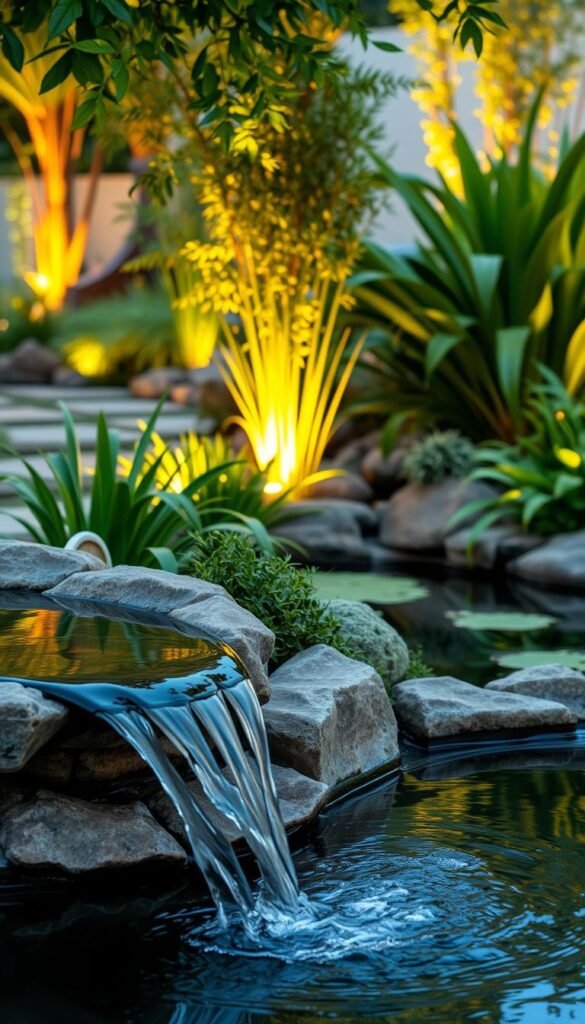Creating a beautiful and functional extension of your home starts with thoughtful planning. Just like arranging rooms indoors, your exterior areas need intentional structure to maximize their potential. Experts compare this process to drafting a house blueprint—every element should serve a purpose while enhancing daily life.
Start by evaluating how you want to use your property. Do you dream of hosting summer dinners or growing fresh herbs? Maybe you need play zones for kids or quiet corners for relaxation. These decisions shape your layout, helping you connect functional areas to corresponding indoor spaces—like placing seating near living room windows.
Successful projects blend aesthetics with practicality. Consider sunlight patterns, soil quality, and local climate when choosing plants or hardscape materials. This attention to detail ensures your creation thrives year-round without constant upkeep.
Throughout this guide, you’ll uncover strategies to balance visual appeal with usability. Learn how to work with existing land features, select durable furnishings, and create seamless transitions between zones. With careful planning, your property becomes a personalized retreat that evolves beautifully through every season.
Understanding Your Outdoor Space and Defining Your Purpose

Transforming your yard starts by listening to the land. Notice where sunlight lingers during breakfast hours or where puddles form after rainstorms. These natural clues reveal your space’s hidden potential and limitations.
Assessing Your Needs and Lifestyle
Track how you actually use your backyard for a week. Do kids race across the grass? Do you crave morning coffee spots shielded from neighbors’ views? Jot down these patterns—they’ll shape your layout better than any Pinterest board. For families needing pet-friendly zones or edible gardens, elevating your space starts with matching dirt to daily habits.
Identifying Functional Areas in Your Yard
Your property likely has built-in dividers. A sprawling oak tree might frame a reading nook, while that awkward slope could become terraced seating. Sketch rough zones for dining, play, and quiet time based on sunlight patterns and existing trees. Soil tests and drainage checks prevent costly mistakes later—sandy soil needs different plants than clay-heavy earth.
Spend evenings observing wind direction and traffic flow between house doors and key areas. These insights help position fire pits away from breezes or play structures near kitchen windows for easy supervision.
Planning Your Garden Layout with Design Principles

Transform your yard into a cohesive sanctuary by mastering smart layout strategies. Start with a scaled sketch that marks permanent fixtures like fences, slopes, and underground utilities. This base map becomes your blueprint for arranging elements that work with—not against—your property’s natural flow.
Building Your Property Blueprint
Grab graph paper and plot existing trees, walkways, and water sources. Note where shadows fall at midday and which areas stay soggy after storms. These details help position seating zones where sunlight warms winter mornings or shade cools summer afternoons. Pro tip: Use colored pencils to test different landscape design principles before committing to changes.
Blending Surfaces and Routes
Choose pathway materials that echo your home’s style—rustic flagstone for cottages or sleek concrete for modern spaces. Wide stepping stones allow two people to walk side-by-side, while gravel paths create charming crunch sounds. Border walkways with low-growing thyme or sedum that withstand foot traffic while adding greenery.
Balance large patios with intimate planting beds to prevent a “paved-over” look. Curve pathways around mature trees instead of removing them—their canopy becomes natural shade for benches. Remember: every material choice impacts drainage, maintenance, and how spaces feel underfoot.
Exploring Essential Elements: Lighting, Water Features, and More

Crafting an inviting outdoor environment requires more than plants and pathways—it’s about layering elements that engage all senses. Thoughtful integration of light, movement, and warmth turns ordinary spaces into memorable retreats that adapt to your needs.
Balancing Natural Light and Ambient Illumination
Maximize daylight by observing where the sun hits hardest during different seasons. Use pergolas or shade sails in overly bright areas, then supplement with soft LED path lights as dusk falls. Uplighting trees adds depth while casting intriguing shadows on fences or walls.
For cooking zones, install task lighting under pergolas or above grills. Choose warm-toned bulbs (2700-3000K) to maintain comfort without attracting insects. Solar-powered options work well for low-traffic paths, while wired systems better serve high-use entertainment areas.
Using Water and Fire Features for Atmosphere
A small recirculating fountain creates soothing sounds that mask neighborhood noise. Even compact wall-mounted designs offer stress-relieving benefits. Pair water elements with fire pits or tabletop lanterns to balance cool and warm tones in your layout.
| Feature Type | Best Placement | Maintenance Level |
|---|---|---|
| Bowl Fountain | Near seating areas | Low (monthly cleaning) |
| Gas Fire Pit | Central gathering spot | Moderate (annual inspection) |
| Pondless Waterfall | Sloped areas | Low (seasonal pump check) |
Portable ethanol fire bowls let you rearrange heat sources as needed. Always position fire features 10+ feet from structures and overhead branches. Combine flickering flames with string lights above dining tables for layered interest that lasts until midnight.
Garden Design Essentials: How to Plan a Stunning Outdoor Space

Your landscape becomes unforgettable when every element tells a story. Strategic combinations of greenery, architectural accents, and eye-catching details transform ordinary yards into curated experiences that invite exploration.
Integrating Plants, Structures, and Focal Points
Start by choosing one showstopper—like a Japanese maple with fiery fall colors or a stone fountain. Position it where sightlines naturally converge, such as where pathways meet or opposite windows. This anchor piece establishes rhythm, guiding visitors through your space.
Pair bold plants with supportive structures. Climbing roses on a wrought-iron arbor create vertical drama, while raised beds edged with reclaimed brick add texture. Remember: hardscape materials should echo your home’s architecture—weathered wood for cabins, sleek metal for modern homes.
Layer plant heights and bloom times for year-round appeal. Place low-growing thyme near seating areas where its scent releases when brushed. For creative gardening ideas, mix ornamental grasses with sculptural succulents in staggered groupings. This approach creates movement while hiding fading foliage.
Balance is key. A minimalist water feature might pair with wildflower meadows, while intricate tilework could stand alone beside simple evergreens. Test arrangements by viewing them from multiple angles—your favorite chair, the kitchen sink, or the driveway entrance.
Maximizing Vertical Space with Trellises and Structures

Elevate your growing potential by looking upward—vertical solutions transform cramped areas into lush, productive zones. Trellises give vining crops room to thrive while keeping beds tidy and accessible. This approach works equally well in urban balconies and sprawling yards.
Why Vertical Supports Boost Plant Health
Trellises create breathing room for tomatoes, cucumbers, and pole beans. When plants climb instead of sprawl, leaves dry faster after rain—reducing mildew risks by up to 40%. Air circulation improves pest resistance, and harvesting becomes a back-friendly task.
Choose materials based on your crops’ weight. Lightweight bamboo suits peas and nasturtiums, while welded steel supports hefty winter squash. Position structures where they’ll cast afternoon shade on heat-sensitive greens like lettuce.
| Material | Best For | Lifespan |
|---|---|---|
| Cedar | Flowering vines | 7-10 years |
| Galvanized Metal | Fruiting plants | 15+ years |
| PVC | Temporary setups | 3-5 years |
Turn functional pieces into design assets. A curved obelisk becomes a rose-covered sculpture, while grid panels form living screens between seating areas. Leave structures standing post-harvest—their frost-kissed silhouettes add winter interest.
Pair trellises with raised beds for ergonomic access. Train melons up slanted frames to save ground space for root vegetables. This layered approach triples yields without expanding your footprint—perfect for small-space enthusiasts.
Incorporating Sustainable Practices in Your Garden
Building an eco-conscious yard doesn’t mean sacrificing beauty—it’s about working smarter with nature. Small changes in plant selection and material choices create thriving spaces that give back to local ecosystems while saving resources.
Smart Plant Choices and Water Wisdom
Native species like purple coneflowers or oakleaf hydrangeas adapt effortlessly to your region’s soil and weather. They need 70% less water than non-native varieties while sheltering butterflies and songbirds. Pair them with drip lines that target roots directly—this method uses 90% less water than sprinklers.
Rain barrels transform storm runoff into free irrigation. Connect multiple barrels for dry spells, or install a rain garden to filter pollutants naturally. These systems cut municipal water bills and protect nearby streams from chemical runoff.
Earth-Friendly Surfaces and Creative Reuse
Swap concrete for permeable pavers made from recycled glass or crushed stone. They let rainwater seep into the ground, reducing flooding. Old bricks from demolition sites make charming walkways, while salvaged timber becomes raised beds bursting with herbs.
Local stone quarries offer unique edging materials that blend seamlessly with your terrain. For sustainable landscaping principles, mix these elements with clover lawns that fertilize themselves and resist droughts.
Repurposing isn’t just eco-smart—it adds character. Turn broken pottery into mosaic stepping stones or fashion trellises from old ladders. Permaculture design strategies show how these features build self-sustaining ecosystems where every element serves multiple purposes.
Designing Outdoor Living Areas for Relaxation and Entertainment
Your backyard becomes an extension of your home when divided into purposeful zones. These outdoor living spaces mirror interior rooms—each serving unique needs while maintaining visual harmony. Start by sketching activity hubs that match your lifestyle, like fire pit circles for marshmallow nights or dining nooks for sunset dinners.
Creating Comfy Seating and Dining Zones
Choose furniture that blends durability with comfort. Powder-coated aluminum withstands coastal salt air, while teak develops a silvery patina over time. Arrange pieces in U-shapes or circular groupings to encourage conversation. Add outdoor-rated cushions in fade-resistant fabrics for plush appeal.
| Material | Best For | Care Needs |
|---|---|---|
| All-Weather Wicker | Frequent use | Hose down monthly |
| Stainless Steel | Modern designs | Wipe with vinegar |
| Cedar | Rustic settings | Oil annually |
Scale matters. A 6-seater table suits family meals, while loveseats create intimate corners. Tuck storage ottomans under side tables for extra blankets—perfect for chilly evenings.
Establishing Distinct Garden Rooms
Define areas without walls using clever markers. Low boxwood hedges separate dining zones from play spaces. Hang string lights above lounge spots to create “ceilings,” or use pergolas draped with climbing roses as natural dividers.
Connect zones with winding gravel paths bordered by lavender. This guides movement while releasing fragrance when brushed. Built-in planters double as space dividers and herb gardens—snip rosemary for grilled dishes right from your seat.
Enhancing Visual Appeal with Finishing Touches and Decor
The final layer of your landscape’s personality shines through curated accents that reflect your taste. Small details like mosaic stepping stones or hand-painted planters infuse character while guiding the eye through your space. These elements should complement—not compete with—your existing layout.
Adding Decorative Elements and Lighting Accents
Mix textures and colors to create depth. Repurposed shutters become vertical herb displays, while solar lanterns cast warm glows on winding paths. Strategically placed lighting highlights focal points, like a weathered bench under a maple tree or a bubbling birdbath.
Incorporate DIY touches for a personal vibe. Upcycled materials like vintage teacups or driftwood wind chimes add whimsy without breaking the bank. For inspiration, explore DIY garden art projects that turn everyday items into conversation starters.
Balance bold hues with neutral backdrops. A cobalt-blue ceramic pot pops against gray gravel, while terracotta planters harmonize with earthy tones. Repeat colors in cushions or flowering annuals to unify your aesthetic. Remember: subtlety often creates lasting beauty.






